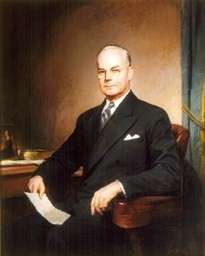John Wesley Snyder (US Cabinet Secretary)
| John W. Snyder | |
|---|---|
 painted by Greta Kempton | |
| 54th United States Secretary of the Treasury | |
|
In office June 25, 1946 – January 20, 1953 | |
| President | Harry S. Truman |
| Preceded by | Fred M. Vinson |
| Succeeded by | George M. Humphrey |
| Personal details | |
| Born |
John Wesley Snyder June 21, 1895 Jonesboro, Arkansas, U.S. |
| Died |
October 8, 1985 (aged 90) Seabrook Island, South Carolina, U.S. |
| Resting place | Washington National Cathedral, Washington, D.C., U.S. |
| Political party | Democratic |
| Spouse(s) |
Evlyn Cook Snyder (m. January 5, 1920 - d.) |
| Children | Edith Drucie Snyder |
| Alma mater | Vanderbilt University |
| Signature |
|
John Wesley Snyder (June 21, 1895 – October 8, 1985) was an American businessman and senior federal government official. Thanks to a close personal friendship with President Harry S Truman, he became Secretary of the Treasury in the Truman administration. Historian Alonzo Hamby emphasizes Snyder's conservatism, stating that he was:
- openly skeptical of New Dealism, broad-gauged social programs, and intellectuals who believed the economy could be run from Washington.[1]
Early life
Snyder was born in Jonesboro, Arkansas, on June 21, 1895, to Jesse Hartwell Snyder and his wife Ellen (Hatcher). He studied at Vanderbilt University's engineering school for one year before serving in the Army during World War I.
Washington
Snyder moved to Washington in the early 1930s with a broad background in banking and business. He held several public and private offices including National Bank Receiver in the Office of the Comptroller of the Currency, Federal Loan Administrator, and Director of War Mobilization and Reconversion. In the last office he played a leading part in the transition of the American economy from a wartime to a peacetime basis. Liberals complained that he removed federal controls on the economy too quickly after the war, hurting consumers, delaying the housing program and bankrupting small businesses. His biographer says, "His handling of the steel crisis in 1946 was an even greater fiasco."[2]
Treasury Secretary
Snyder was appointed Secretary of the Treasury in 1946 by his close personal friend President Harry S. Truman, with whom he had served in the Army Reserves. Editorials criticized the cronyism and said his narrow range of experience made him unfit for the job.[3] His task as Secretary was to establish a stable postwar economy. The main points of his program were maintaining confidence in the credit of the government, reducing the federal debt, keeping the interest rate low, and encouraging public thrift through investment in U.S. Savings Bonds. A deeply conservative businessman, he had faith that the free economy would work itself out. He reduced the national debt while balancing the budget. He was reluctant to spend large sums on the Marshall Plan of aid to Europe. Snyder had little diplomatic experience, and in his negotiations with British leadership regarding Britain's need for dollars, he angered his counterparts. Paul Nitze, an American negotiator, recalled a meeting in Washington in September 1949:
- at one point Secretary Snyder made some very -- well, remarks which I thought were wholly undiplomatic and rude and showed his lack of concern for the UK problem (the general sense of them was why didn't the UK get a hold of itself, and why didn't its people do some work for change and why don't you cure those productivity problems in the United Kingdom, and why don't you get off your butt).[4]
At another meeting his British counterpart, Chancellor of the Exchequer Hugh Gaitskell, concluded that Snyder was, "a pretty small minded, small town semi-isolationist.” Happily for the British Snyder was outmaneuvered by Secretary of State Dean Acheson, who was much more sympathetic.[5]
Snyder funded the Korean War by increasing taxes. He feuded constantly with the Federal Reserve system, until it became more independent in 1951. He retired from government in 1953 at the end of Truman's second term.
Snyder died in Seabrook Island, South Carolina, on October 8, 1985, at the age of 90, and was buried in Washington National Cathedral.

Notes
- ↑ Alonzo Hamby (1995). Man of the People: A Life of Harry S. Truman. Oxford UP. p. 374.
- ↑ Vibha Kapuria-Foreman (1996), p 343
- ↑ Vibha Kapuria-Foreman (1996), p 343
- ↑ Peter Hennessy, Never Again: Britain 1945-1951 (2006) p 340.
- ↑ Kenneth O. Morgan, Labour in power, 1945-1951 (1985) p 479
Further reading
- Fielding, Jeremy. "The primacy of national security? American responses to the British financial crisis of 1949." Diplomacy and Statecraft 11#1 (2000): 163-188.
- Heidenheimer, A. J. "John Snyder's Hope Chest," The New Republic, 15 October, 1951 pp 12-13
- Kapuria-Foreman, Vibha. "John W. Snyder" in Bernard S. Katz and C. Daniel Vencill, eds. (1996). Biographical Dictionary of the United States Secretaries of the Treasury, 1789-1995. Greenwood. pp. 341–46.; also online
Primary sources
- Oral History Interview with John W. Snyder, at the Truman Library
- Snyder, John F. "The Treasury and Economic Policy" in Francis Howard Heller, ed. Economics and the Truman administration (Univ Press of Kansas, 1981). pp 24–27
External links
- A selection of Snyder's papers related to the 1951 Accord, are available on the FRASER
- Finding aid for Snyder's papers held at the Truman Presidential Library
| Political offices | ||
|---|---|---|
| Preceded by Fred M. Vinson |
U.S. Secretary of the Treasury Served under: Harry S. Truman 1946–1953 |
Succeeded by George M. Humphrey |

